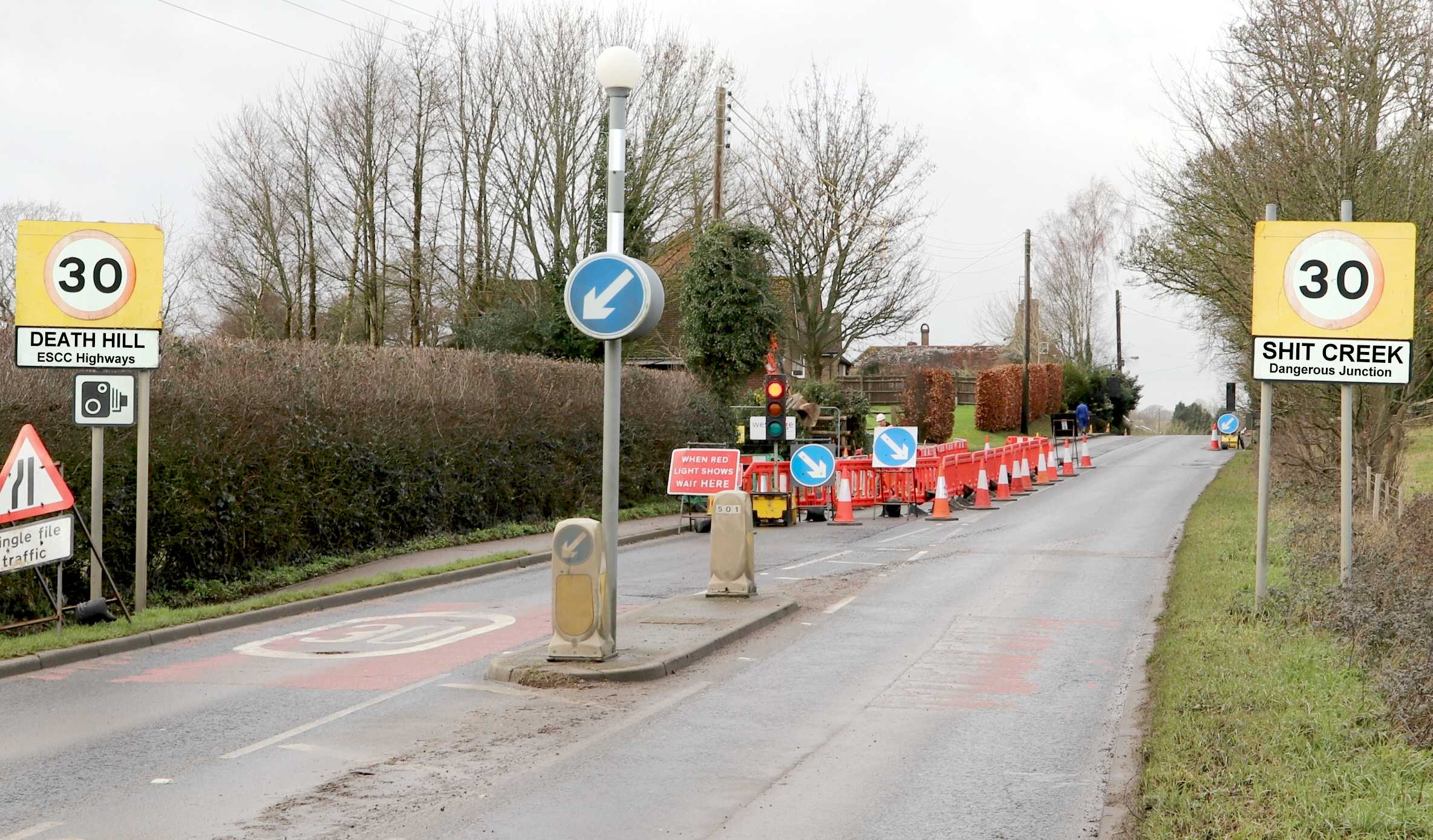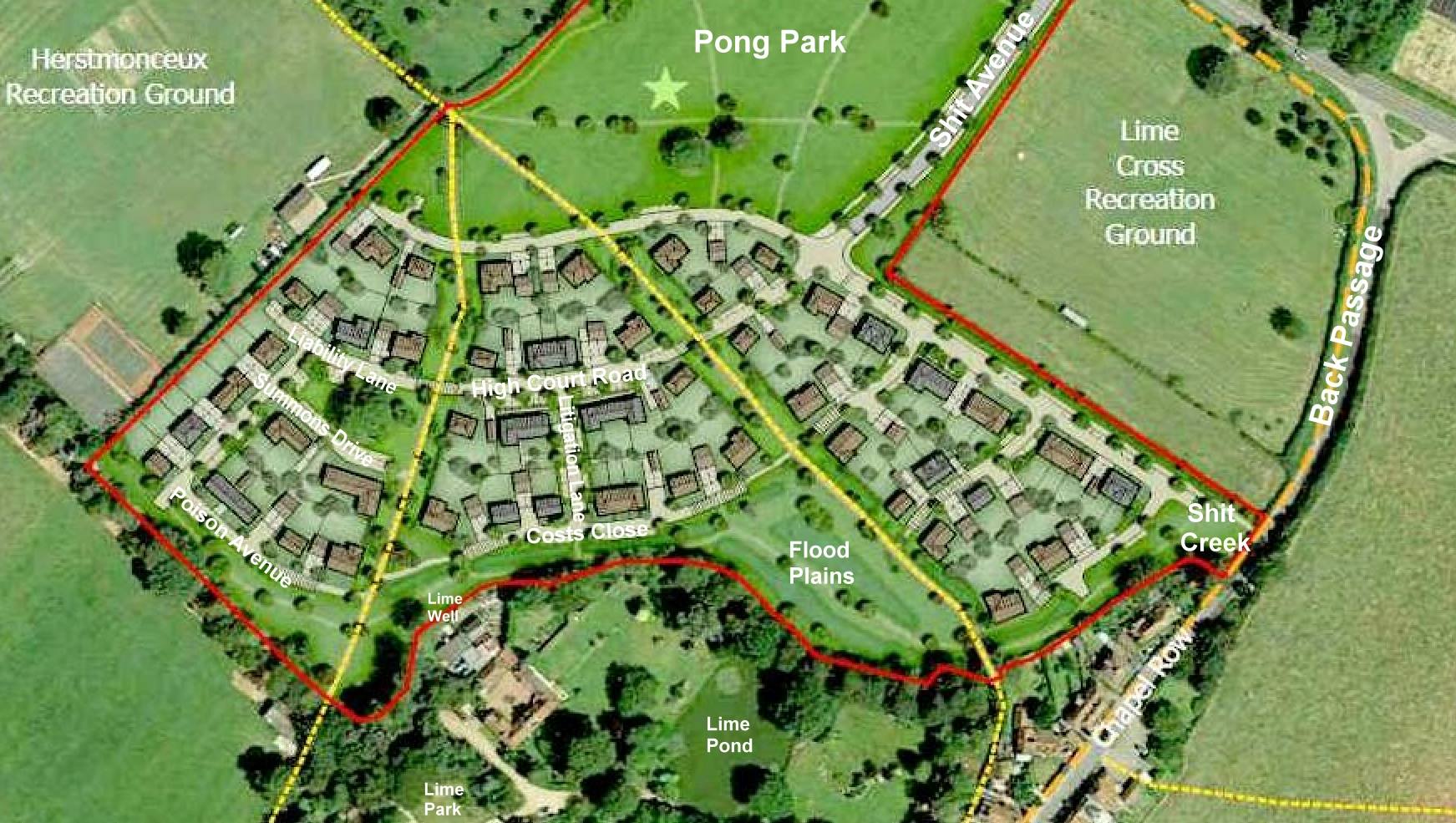|
JUDICIAL REVIEW
Please use our A-Z INDEX to navigate this site or see our HOMEPAGE
|
|
A BUM DEAL - In the words of John McEnroe, "You cannot be serious." A junction for up to 70 houses, or 140 cars leaving for work and school, onto a busy main road that is already inadequate for the current traffic flow. This road planning is thought by many to be the most dangerous bit of money grabbing corruption. What were East Sussex Highways thinking of in approving this tiny entrance, devoid as it is of a suitable visibility play. It's seems like Wednesbury Corporation attitudes all over again. How dare they put so many local residents at this level of traffic risk. Locals are calling this stretch of road Death Hill, and we agree with that sentiment. It is an accident waiting to happen in our view. This is the entrance to Shit Avenue, as the locals are referring to it, leading to Pooh Park.
IMMINENT THREAT OF POISONING - A Heron seen here with Mallard Ducks on the pond in Lime Park on the 27th of September 2020. It is proposed by Latimer Developments Limited, to pass surface water drainage through this pond, despite the detrimental effect that bio accumulative poisoning is sure to have from pesticides used on the gardens of the 70 houses they intend building.
In 1997 suspected planning crime was reported to Sussex police, following a petition to Wealden District Council. There were 12 separate complaints from unrelated complainants, but this police force failed to investigate any of the reported crimes. Now some 23 years later, suspect planning consents are still flowing. It is alleged that this is one case where the planning officers have turned a blind eye to their duty to protect these birds - and of course the fish and flora of Lime Park. One thing is for sure, Sussex police are unlikely to investigate any matter concerning any Wealden planning officer, let alone tangle with the likes of the developers, or any person doing a deal with the developers. Even if fraud or conspiracy to pervert the course of justice, or indeed to kill these birds is involved. Killing a bird by poisoning is an imprison-able offence that affects the director of any company involved.
When considering approving or rejecting a planning application, a Council owes the eventual occupiers of such houses and the neighboring land owners a duty to be reasonable.
It could be argued that the same duty rests with the applicant is cases involving a major housing development, such as Latimer Developments, and that they are bound by the Human Rights Act 1998, where any proposed development affects third parties.
In the case of an open space that has been used by the public for over 20 years, there may be special conditions as to notification of the public when considering development that would change the open space to closed residential space and access roads.
The council did not consider how it might replace the space for walkers, and consultation as to use of the field. The decision should be reviewed in light of the principle in section 123 of the Local Government Act 1972, as to disposal of land and the ‘open space’ notification requirement, allied to the need to keep plans relating to public footpaths up to date.
In the case of land that supplies water to a well providing drinking water, there must be a special duty not to contaminate such supply.
In
the case of ponds with fish
and birds,
and any potential for bio-accumulation, that may or many not affect any
Site of Special Scientific Interest (SSSI), it follows that there is a
special duty not to harm any animals or the habitat(s).
WHO PAYS FOR BEING UNREASONABLE ? - In a
THE CASELAW
The case that sets the benchmark for grounds in applications to the administrative (High Court) for Judicial Review are set out in Associated Provincial Picture Houses v Wednesbury Corporation 1948.
A standard of unreasonableness used in assessing an application for judicial review of a public authority's decision. A reasoning or decision is Wednesbury unreasonable (or irrational) if it is so unreasonable that no reasonable person acting reasonably could have made it. The test is a different (and stricter) test than merely showing that the decision was unreasonable.
It has been observed that numerous decisions have unreasonableness as a common factor. Referring in the main to the duty of a public body to act reasonably at all times.
One issue that tends to cloud council thinking is making money. But public authorities spending public money need to ensure not only that they are complying with relevant statutes, but also that they are acting prudently and in the light of all material considerations. They must have at their fingertips, all the material consideration in unbiased fashion. It is not sufficient to consider only those issues that will enable grant, they must also consider matters that tend to hinder any proposal - no matter how much they want the development to proceed financially.
SEPTEMBER 17 2020 - Shit handling pipes, installation at Shit Creek, Herstmonceux, the field adjacent is to be built on with 70 houses flushing excrement down a network of pipes that could spring leaks at any time. But, of even more concern is the pollution from the surface run off of pesticides from 70 gardens and garages, through Lime Pond. In that Southern Water are providing the infrastructure to make that pollution a reality, they may be held to be vicariously liable or part of a conspiracy to kill wild animals. If any of the soil pipes from the proposed houses were to leak into the pond and kill any animal, they would be criminally liable for sure. It seems that this installation proceeded without conditions having been met by Latimer Developments, with Southern Water helping the property developers to undermine the due process. In our book that qualifies as a conspiracy to pervert the course of justice, contrary to duties imposed by the Fraud Act 2006. We are following this case and the injustices alleged, such as violating the peaceful enjoyment of the adjacent property. This may well be a criminal offence, but could equally be the subject of a Judicial Review.
LINKS & REFERENCE
https://www.bailii.org/ew/cases/EWHC/Admin/2015/16.html https://www.bailii.org/ew/cases/EWHC/Admin/2015/16.html
COUNTRYSIDE ABOMINATION & HUMAN RIGHTS VIOLATIONS - If you buy one of these (proposed) houses, not only will you be adding to global warming, but you could be letting yourself in for many years of litigation, not least of which is the potential to be charged under groundwater contamination laws. At least 40% of the houses shown are in a direct line to poison the only working well in the village - Lime Well - in the lower left of the picture. The developers will also fall foul of the Human Rights Act 1998, for interfering with the peaceful enjoyment of a water supply.
Please use our A-Z INDEX to navigate this site
|
|
|
|


